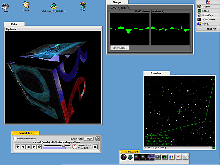
AmiBeOS
Developer: Amiga Inc/Be
Year of Announcement: 1998
Since Amiga Inc announced that they would be licensing an
existing kernel many believed that Be would eventually be chosen as
the OS Partner. The company was created by a group of Amiga users
and the system was aimed at the traditional Amiga desktop video
market. On April 1st 1998 these rumours shot into high
gear as CU Amiga ran an article on their website with the heading
"AmigaInc License BeOS". Plans to make a
BeOS version of MUI the standard GUI API. And an Amiga bytecode
emulator was announced that would allow all Amiga 68k applications
to run in a BeOS workgroup. The OS was to be released for both 68k
and PPC allowing both current and future users to run the next
generation system. A spokesman for BE Inc said, the move is, for
BeOS, "... like returning to our roots." It sounded to
good to be true. In fact it was. The article was an elaborate April
fools joke by CU Amiga Magazine and was revealed the next day.
However, it revealed an element of truth. Be was one of the seven
OS Partners that were under consideration by Amiga Inc and their
operating system had many features that made it perfect for a
successor to the Amiga platform. As one of the most popular
contenders both Amiga Format and CU Amiga Magazine covered the
features of the operating system. Many Amiga journalists "in the
know" had official word from their sources that Be was the OS
Partner although they were only allowed to indicate this in the
form of "speculation." Soon after Amiga Inc issued a "rumour
control" regarding Be.
The BeOS is the OS partner,
and they are what everyone should develop to.
WRONG! Please do not jump at every rumor. As mentioned before,
Be is ONE of the OS partners that we are considering. There are at
least 6 others that are on the list. We have narrowed the
contenders, and we hope to have all of this wrapped up
soon.
After the new OS Partner was announced in November the cat was let
out of the bag and a few Amiga developers that were "in the know"
stated that Be was to be the OS Partner but they pulled out at the
last minute. One of the most vocal was Mick Tinker who commented in
a Usenet post on the 15th November 1998:
QNX is excellent though. Having done a driver for
BeOS I can definitely say that the system, development tools and
lack of stability in the specification does make me a *lot* happier
that negotiations fell through...
The big announcement that Amiga Inc was to make had to be cancelled
at the last minute. Amiga Inc was left with a problem and could
only reveal developments of AmigaOS 4.0 (now known as OS5Dev), in
the form of a Development system, dubbed "November Box" by the
Amiga press as it was due for release in November. It became
increasingly obvious that the careful planning that had gone into
deciding the time needed for development, pushing the developers
system back until the early part of 1999. At the time of writing
the actual developers system has not been seen by the press
although rumours suggest that AmigaOS 5 will be ready for release
within the year.
What would the Amiga be now?

The Amiga would be where BeOS is now. A powerful,
multi-processing system that could run on PowerPC and x86. Even the
BeOS version numbers correspond to the Amiga timeline. Could BeOS 4
that has just been released have been the AmigaOS 4 developer
project? It would certainly have placed the Amiga in a stronger
position than it is at present, BeOS has increased in popularity
over the last year since it was released for Intel system with
coverage in a number of PC magazines. In contrast the Amiga is only
mentioned in news items or small sections of Computer Shopper. An
AmiBeOS would have also created the feeling that the Amiga was
coming home- using an OS kernel that was itself influenced by the
Amiga. Whilst it would have been in a stronger position on the
desktop, as a small OS specifically for palmtops, or domestic units
the BeOS is too large. I cannot help thinking that the Amiga-BeOS
crossover would have attracted more media attention but would
produce a weaker OS in the long run.
BACK
|













